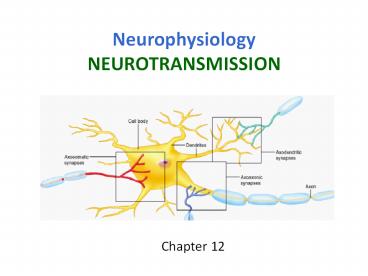Neurophysiology NEUROTRANSMISSION - PowerPoint PPT Presentation
1 / 13
Title:
Neurophysiology NEUROTRANSMISSION
Description:
Title: Chapter 12 Subject: Nervous Tissue Author: maria Last modified by: Murray, Kim L Created Date: 3/15/2006 4:31:41 AM Document presentation format – PowerPoint PPT presentation
Number of Views:297
Avg rating:3.0/5.0
Title: Neurophysiology NEUROTRANSMISSION
1
Chapter 12
- Neurophysiology NEUROTRANSMISSION
2
Chemical Synapse Vocabulary
- Presynaptic neuron
- Postsynaptic neuron
- Synapse means of communication between each
neuron and the next cell space - Excitatory neurotransmitters chemicals that
cause nerve impulses (e.g. ACh, glutamate) - Inhibitory neurotransmitters chemicals that
inhibit nerve impulses (e.g.gama aminobutyric
acid GABA)
3
Steps of Synaptic Transmission
- Step 1 Action potential arrives at the axon
terminal - Step 2 Release of neurotransmitter from a
vesicle - Step 3 Neurotransmitter binds to receptor site
on ion channel on postsynaptic neuron - Step 4 Ions cross the membrane through open
channels - Step 5 The influx of ions causes action
potential in postsynaptic neuron (details are
coming up - ?) - Step 6 Removal of neurotransmitter
- www.mind.ilstu.edu/flash/synapse_1.swf
4
Major Neurotransmitters in the Body
- Acetylcholine regulates muscles and memory
mostly excitatory - Dopamine produces feelings of pleasure mostly
inhibitory - GABA major inhibitory neurotransmitter in the
brain - Glutamate - major excitatory neurotransmitter in
the brain - Seratonin involved in many functions including
mood, appetite, and sensory perception
inhibitory in pain pathways - Norephinephrine regulates normal brain
processes and is a part of the fight-or-flight
response usually excitatory
5
Resting Membrane Potential (RMP)
The outside of the cell is more positive (Na)
than the inside (K)
- Electrical charge gradient associated with the
cell membrane typically -70 millivolts
6
Protein Channels
- Ion protein channels are chemically, mechanically
or voltage regulated - Ion channels open in response to the particular
stimulus and allow ions to flow in or out the
cell - Flow of ions changes the membrane
potential/voltage - Sudden change in membrane potential that
accompanies activity action potential (nerve
impulse)
7
A Special Ion Channel Na/K ATPase
- When a neuron is at rest, there is a slow leakage
of Na into the cell K out of the cell (along
concentration gradient) - Na/K ATPase pumps 3 Na out and 2 K in per ATP
hydrolysis thus prevents reaching equilibrium
of Na K ions
8
Steps of Action Potential
- Step 1 Resting
- Step 2 Depolarization
- Step 3 Repolarization
- Step 4 Return to normal permeability
9
- Step 1 Resting (-70 mV)
- Step 2 Depolarization
- Neurotransmitters bind to their receptors on a
postsynaptic neuron, chemically gated Na
channels open, Na flows in, and local potential
reaches a threshold limit (-55mV) - Then, voltage-gated Na channels open and Na
ions rush into the cell - Membrane potential reaches 30 mV
10
- Step 3 Repolarization
- Na channels close when the inside of the axon
becomes sufficiently positive (30 mV) - Voltage-regulated K channels open K flows out
11
- Step 4 Return to resting potential
- Ion movements drive the membrane potential back
toward resting membrane potential value - Na/K ATPase continues pumping ions, adjusting
levels back to resting equilibrium levels - Hyperpolarization - briefly the exterior of the
membrane is more negative than resting potential
voltage level - Refractory period - the time during which a nerve
cell cannot generate another action potential
despite stimulation
12
And Another Look
- www.blackwellpublishing.com/matthews/channel.html
- www.blackwellpublishing.com/matthews/actionp.html
13
- Closer Look at Action Potential
- http//itc.gsw.edu/faculty/gfisk/anim/actionpotent
ial.swf































